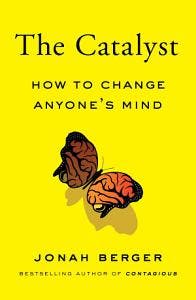Booknotes: The Catalyst
Booknotes for The Catalyst: How to Change Anyone’s Mind by Jonah Berger

There are 5 main roadblocks to change: REDUCE: Reactance, Endowment, Distance, Uncertainty, Corroborating Evidence
REACTANCE
Telling people not to do something has the opposite effect
People feel the need for control, autonomy, freedom – even if it makes them feel worse, they want to choose
Restriction generates a psychological action called reactance – an unpleasant state when people feel that their freedom is lost / negative feeling when someone is trying to persuade us – like our defense system goes off
The simplest countermeasure is avoidance/ignoring
- The more complex response is counter-arguing – actively combating the message
Catalysts get people to persuade themselves (like teen smoking ads example)
There are 4 ways to guide this:
Provide a menu – a set of options from which people can choose guided choice. Giving multiple options makes them think which one is better, and pick one.
Ask, don’t tell – asking a lot of questions shifts the listener’s role to try to figure out an answer. People are more likely to follow their own answer and driven to action. Questions encourage listeners to commit to the conclusion.
- Highlight a gap – a disconnect between someone’s thoughts and actions. When attitudes and behaviors conflict, people get uncomfortable (what they tell others to do vs what they do themselves)
- “practice what you preach”; asking what they would do, not telling them
- Start with understanding – be willing to listen, don’t make it about you, show compassion and understanding -> build trust -> create change. Build a relationship, don’t just try to persuade
ENDOWMENT
Status quo bias – people tend to overvalue what they already have. We become attached with something we own and value it more.
When deciding whether to do something, potential disadvantages are weighed more heavily
Switching costs – the financial, psychological, or procedural impediments to switching products and services
To ease endowment:
Surface the cost of inaction – sticking with the status quo/ doing nothing has a downside. Change doesn’t seem worth it if the status quo is okay, but surfacing the cost of inaction helps people realize that sticking with the status quo isn’t as costless as it seems. The cost-benefit timing gap stymies action; benefits of change take longer
Burn the ships – take inaction off the table, it encourages people to set aside the old and think about which new thing is worth pursuing (example of Windows 7 support)
DISTANCE
When trying to change minds, giving information, facts, evidence, does not always work
Region of rejection – the range of perspectives people strongly disagreed with or actively rejected as wrong
Confirmation bias – people search for, interpret, and favor information in a way that confirms or supports their existing beliefs
3 ways to mitigate distance are:
- Find the movable middle – Many people have a small zone of acceptance and a wide range of rejection (swing voters)
- Ask for less – when people move their position on the field, their zones and regions move with them. The final ask is now in more people's zone of acceptance.
- Switch the field to find an. Unsticking point – “deep canvassing” encourages voters to find a parallel situation from their own experience; when they felt similarly to reduce prejudice (example of asking voter to think about love for his disabled wife)
UNCERTAINTY
Uncertainty tax – devaluing of things uncertain
When choosing between a sure thing and a risky one:
The more change involves uncertainty, the less interested people are in changing. The more uncertainty, the less valuable the item becomes
Uncertainty makes people wait and stick with whatever they have always been doing, at least until it resolves
How do we get people to un-pause?
Diffusion of Innovations – Rogers identifies “trialability” as the key factor in variance (how easy it is to try something)
To reduce uncertainty by lowering the barrier to trial:
- Harness freemium – giving the service for free to get people to try it. Users eventually will have to pay to upgrade. Users will convince themselves,
- Reduce up-front costs – the real barrier is uncertainty. Shrink the amount of time, money, or effort required at the outset to experience something. (free shipping)
Drive discovery – if people don’t know something exists or don’t think they will like it, they are unlikely to try it
Make it reversible – giving free trials, return periods, money-back guarantees
CORROBORATING EVIDENCE
Weak attitudes vs strong attitudes: If an opinion is important to you, it takes more evidence to change
- pebble vs boulder: If you’re trying to lift a pebble, you only need a little evidence to change, but if you’re trying to move a boulder, much more effort is needed
The translation problem – preferences are subjective, so when it comes to changing minds, transition comes into play. When they get a recommendation, they have to figure out what it means for them.
More source saying or doing the same thing can provide more proof
When finding corroborating evidence, it’s important to consider who, when, and how:
Who else to involve (which sources are most impactful) – similarity matters – (laugh track ex) – ratings, reviews from people similar to you. The translation problem is less of a problem wgen there’s less need for translation. Diversity is also important for changing minds. It matters if they provide additional information.
When to space corroborating evidence over time – concentrating the proof is more effective, in a short time one rather than separated times over a long period. Concentration increases impact.
How to best deploy scarce resources when trying to change minds on a larger scale – concentration is helpful in changing one person’s mind. But for larger-scale change. Sprinkler and hose strategy for weak attitude, strong one, respectively. When more corroborating evidence is needed, using a fire hose is more effective.
